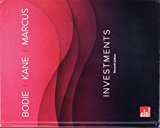
Investments, 11th Edition (exclude Access Card)
11th Edition
ISBN: 9781260201543
Author: Zvi Bodie Professor; Alex Kane; Alan J. Marcus Professor
Publisher: McGraw-Hill Education
expand_more
expand_more
format_list_bulleted
Question
Chapter 9, Problem 19PS
Summary Introduction
To calculate:
The beta of stock, if the expected return of the stock stands to be 6%
Introduction:
Beta refers to the measure pertaining to volatility of stock with respect to the market. The individual stock are ranked in accordance with how much deviation it has when compared with the market. The beta of stock that swings more in comparison to market possess beta greater than 1.
Expert Solution & Answer
Want to see the full answer?
Check out a sample textbook solution
Students have asked these similar questions
What is the present value of $5,000 to be received in 5 years if the discount rate is 6%?
If you invest $1,000 today at an annual interest rate of 5% for 3 years, what will the future value be? Need help
If you invest $1,000 today at an annual interest rate of 5% for 3 years, what will the future value be?
Chapter 9 Solutions
Investments, 11th Edition (exclude Access Card)
Ch. 9 - Prob. 1PSCh. 9 - Prob. 2PSCh. 9 - Prob. 3PSCh. 9 - Prob. 4PSCh. 9 - Prob. 5PSCh. 9 - Prob. 6PSCh. 9 - Prob. 7PSCh. 9 - Prob. 8PSCh. 9 - Prob. 9PSCh. 9 - Prob. 10PS
Ch. 9 - Prob. 11PSCh. 9 - Prob. 12PSCh. 9 - Prob. 13PSCh. 9 - Prob. 14PSCh. 9 - Prob. 15PSCh. 9 - Prob. 16PSCh. 9 - Prob. 17PSCh. 9 - Prob. 18PSCh. 9 - Prob. 19PSCh. 9 - Prob. 20PSCh. 9 - Prob. 21PSCh. 9 - Prob. 22PSCh. 9 - Prob. 23PSCh. 9 - Prob. 24PSCh. 9 - Prob. 1CPCh. 9 - Prob. 2CPCh. 9 - Prob. 3CPCh. 9 - Prob. 4CPCh. 9 - Prob. 5CPCh. 9 - Prob. 6CPCh. 9 - Prob. 7CPCh. 9 - Prob. 8CPCh. 9 - Prob. 9CPCh. 9 - Prob. 10CPCh. 9 - Prob. 11CPCh. 9 - Prob. 12CP
Knowledge Booster
Similar questions
- A bond with a face value of $1,000 pays a 5% annual coupon and has 10 years to maturity. If the market interest rate is 6%, what is the price of the bond?arrow_forwardWhich of the following represents a source of cash?A) Repayment of a loanB) Purchase of inventoryC) Issuance of new equity sharesD) Purchase of fixed assets Need hwarrow_forwardWhich of the following represents a source of cash?A) Repayment of a loanB) Purchase of inventoryC) Issuance of new equity sharesD) Purchase of fixed assets Exarrow_forward
- The payback period is:A) The time it takes for a project to be profitableB) The time required to recover the initial investmentC) The total time a project lastsD) The period during which a project generates revenuearrow_forwardA bond selling below its par value is referred to as:A) A discount bondB) A premium bondC) A callable bondD) A convertible bondneed help!arrow_forwardA bond selling below its par value is referred to as:A) A discount bondB) A premium bondC) A callable bondD) A convertible bondarrow_forward
- What is the primary purpose of a capital budgeting decision?A) To maximize cash flowsB) To evaluate long-term investment opportunitiesC) To manage short-term liabilitiesD) To determine the company's dividend policyneed helparrow_forwardWhat is the primary purpose of a capital budgeting decision?A) To maximize cash flowsB) To evaluate long-term investment opportunitiesC) To manage short-term liabilitiesD) To determine the company's dividend policyarrow_forwardWhat is diversification in portfolio management?A) Investing in a single industry to maximize returnsB) Spreading investments across different assets to reduce riskC) Concentrating investments in a high-performing stockD) Avoiding low-risk investments entirelyarrow_forward
- What is the primary purpose of a capital budgeting decision?A) To maximize cash flowsB) To evaluate long-term investment opportunitiesC) To manage short-term liabilitiesD) To determine the company's dividend policy explain.arrow_forwardQuestion 10: What is the primary purpose of a capital budgeting decision?A) To maximize cash flowsB) To evaluate long-term investment opportunitiesC) To manage short-term liabilitiesD) To determine the company's dividend policyarrow_forwardNitai (age 40) contributes 10 percent of his $100,000 annual salary to a Roth 401(k) account sponsored by his employer, AY Incorporated. AY Incorporated matches employee contributions dollar-for-dollar up to 10 percent of the employee's salary. However, AY matches by contributing to the employee's traditional 401(k) account because the employer contributions are not fully vested to the employee at the time of the contribution. Nitai expects to earn a 7 percent before-tax rate of return. Assume he leaves the contributions in the Roth 401(k) and traditional 401(k) accounts until he retires in 25 years and that he makes no additional contributions to either account. What are Nitai's after-tax proceeds from the Roth 401(k) and traditional 401(k) accounts after he receives the distributions, assuming his marginal tax rate at retirement is 30 percent? (Use Table 1, Table 2.) after tax proceeds from distribution roth ira: traditional ira:arrow_forward
arrow_back_ios
SEE MORE QUESTIONS
arrow_forward_ios
Recommended textbooks for you
 Intermediate Financial Management (MindTap Course...FinanceISBN:9781337395083Author:Eugene F. Brigham, Phillip R. DavesPublisher:Cengage Learning
Intermediate Financial Management (MindTap Course...FinanceISBN:9781337395083Author:Eugene F. Brigham, Phillip R. DavesPublisher:Cengage Learning


Intermediate Financial Management (MindTap Course...
Finance
ISBN:9781337395083
Author:Eugene F. Brigham, Phillip R. Daves
Publisher:Cengage Learning
